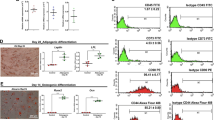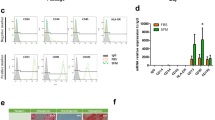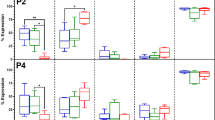Abstract
Objective:
To investigate the effect of glucose and insulin concentrations on differentiation of umbilical cord lining progenitor cells to adipocyte-like cells (ALCs).
Methods:
Cord lining mesenchymal cells (CLMCs) were isolated from the explant of human umbilical cord amniotic membrane. CLMCs were subjected to differentiation under various culture conditions for 20 days. Lipid droplets were confirmed with Oil Red O staining. Gene expressions of adipsin and peroxisome proliferator-activated receptor gamma (PPARγ) were analyzed using reverse transcription-PCR. Leptin and adiponectin secretions were detected using enzyme-linked immunosorbent assay kit.
Results:
CLMCs became irregular, cuboidal-shaped cells that resemble adipocytes, and Oil Red O staining showed the presence of lipid droplets. The gene expressions of PPARγ and adipsin were upregulated. Leptin and adiponectin secretions by naive CLMCs were below the limits of detection. Matured ALCs cultured in low-glucose medium significantly secreted leptin and adiponectin, whereas those in high-glucose medium significantly secreted only leptin. Insulin concentration affects leptin but not adiponectin secretion.
Conclusions:
Under different culture conditions, CLMCs can differentiate into ALCs that resemble adipocytes in either normal-weight or obese individuals. Hence, these ALCs have the potential to be used as an in vitro model to study adipogenesis and obesity, and possibly as a drug discovery model for metabolic disorders.
This is a preview of subscription content, access via your institution
Access options
Subscribe to this journal
Receive 12 print issues and online access
$259.00 per year
only $21.58 per issue
Buy this article
- Purchase on Springer Link
- Instant access to full article PDF
Prices may be subject to local taxes which are calculated during checkout





Similar content being viewed by others
References
Thomson JA, Itskovitz-Eldor J, Shapiro SS, Waknitz MA, Swiergiel JJ, Marshall VS et al. Embryonic stem cell lines derived from human blastocysts. Science 1998; 282: 1145–1147.
Reiser J, Zhang XY, Hemenway CS, Mondal D, Pradhan L, La Russa VF . Potential of mesenchymal stem cells in gene therapy approaches for inherited and acquired diseases. Expert Opin Biol Ther 2005; 5: 1571–1584.
Fu YS, Cheng YC, Lin MY, Cheng H, Chu PM, Chou SC et al. Conversion of human umbilical cord mesenchymal stem cells in Wharton's jelly to dopaminergic neurons in vitro: potential therapeutic application for Parkinsonism. Stem Cells 2006; 24: 115–124.
Baksh D, Song L, Tuan RS . Adult mesenchymal stem cells: characterization, differentiation, and application in cell and gene therapy. J Cell Mol Med 2004; 8: 301–316.
Zuk PA, Zhu M, Ashjian P, De Ugarte DA, Huang JI, Mizuno H et al. Human adipose tissue is a source of multipotent stem cells. Mol Biol Cell 2002; 13: 4279–4295.
Tuli R, Tuli S, Nandi S, Wang ML, Alexander PG, Haleem-Smith H et al. Characterization of multipotential mesenchymal progenitor cells derived from human trabecular bone. Stem Cells 2003; 21: 681–693.
Carraro G, Perin L, Sedrakyan S, Giuliani S, Tiozzo C, Lee J et al. Human amniotic fluid stem cells can integrate and differentiate into epithelial lung lineages. Stem Cells 2008; 26: 2902–2911.
Wang HS, Hung SC, Peng ST, Huang CC, Wei HM, Guo YJ et al. Mesenchymal stem cells in the Wharton's jelly of the human umbilical cord. Stem Cells 2004; 22: 1330–1337.
Weiss ML, Medicetty S, Bledsoe AR, Rachakatla RS, Choi M, Merchav S et al. Human umbilical cord matrix stem cells: preliminary characterization and effect of transplantation in a rodent model of Parkinson's disease. Stem Cells 2006; 24: 781–792.
Lu LL, Liu YJ, Yang SG, Zhao QJ, Wang X, Gong W et al. Isolation and characterization of human umbilical cord mesenchymal stem cells with hematopoiesis-supportive function and other potentials. Haematologica 2006; 91: 1017–1026.
Lim IJ, Phan TT . Isolation of stem/progenitor cells from amniotic membrane of umbilical cord. UK Intellectual Property Office - The Patents & Designs Journal 2008; 6189: GB2432166.
Kita K, Gauglitz GG, Phan TT, Herndon DN, Jeschke MG . Isolation and characterization of mesenchymal stem cells from the sub-amniotic human umbilical cord lining membrane. Stem Cells Dev 2010; 19: 491–502.
Entenmann G, Hauner H . Relationship between replication and differentiation in cultured human adipocyte precursor cells. Am J Physiol 1996; 270: C1011–C1016.
Hauner H, Entenmann G . Regional variation of adipose differentiation in cultured stromal-vascular cells from the abdominal and femoral adipose tissue of obese women. Int J Obes 1991; 15: 121–126.
Janderova L, McNeil M, Murrell AN, Mynatt RL, Smith SR . Human mesenchymal stem cells as an in vitro model for human adipogenesis. Obes Res 2003; 11: 65–74.
Hung SC, Chang CF, Ma HL, Chen TH, Low-Tone Ho L . Gene expression profiles of early adipogenesis in human mesenchymal stem cells. Gene 2004; 340: 141–150.
Nakamura T, Shiojima S, Hirai Y, Iwama T, Tsuruzoe N, Hirasawa A et al. Temporal gene expression changes during adipogenesis in human mesenchymal stem cells. Biochem Biophys Res Commun 2003; 303: 306–312.
Stolzing A, Scutt A . Age-related impairment of mesenchymal progenitor cell function. Aging Cell 2006; 5: 213–224.
White RT, Damm D, Hancock N, Rosen BS, Lowell BB, Usher P et al. Human adipsin is identical to complement factor D and is expressed at high levels in adipose tissue. J Biol Chem 1992; 267: 9210–9213.
Johnson PR, Spiegelman B, Rosen B, Turkenkopf I, Ree H, Greenwood MR . Reduced adipsin mRNA and circulating adipsin protein are modulated by adrenal steroids in obese Zucker rats. Am J Physiol 1990; 259: R184–R188.
Lowell BB, Napolitano A, Usher P, Dulloo AG, Rosen BS, Spiegelman BM et al. Reduced adipsin expression in murine obesity: effect of age and treatment with the sympathomimetic-thermogenic drug mixture ephedrine and caffeine. Endocrinology 1990; 126: 1514–1520.
Maslowska M, Vu H, Phelis S, Sniderman AD, Rhode BM, Blank D et al. Plasma acylation stimulating protein, adipsin and lipids in non-obese and obese populations. Eur J Clin Invest 1999; 29: 679–686.
Pomeroy C, Mitchell J, Eckert E, Raymond N, Crosby R, Dalmasso AP . Effect of body weight and caloric restriction on serum complement proteins, including factor D/adipsin: studies in anorexia nervosa and obesity. Clin Exp Immunol 1997; 108: 507–515.
Kratchmarova I, Kalume DE, Blagoev B, Scherer PE, Podtelejnikov AV, Molina H et al. A proteomic approach for identification of secreted proteins during the differentiation of 3T3-L1 preadipocytes to adipocytes. Mol Cell Proteomics 2002; 1: 213–222.
Hu E, Tontonoz P, Spiegelman BM . Transdifferentiation of myoblasts by the adipogenic transcription factors PPAR gamma and C/EBP alpha. Proc Natl Acad Sci USA 1995; 92: 9856–9860.
Qiao C, Xu W, Zhu W, Hu J, Qian H, Yin Q et al. Human mesenchymal stem cells isolated from the umbilical cord. Cell Biol Int 2008; 32: 8–15.
Gregoire FM, Smas CM, Sul HS . Understanding adipocyte differentiation. Physiol Rev 1998; 78: 783–809.
Reidy SP, Weber J-M . Leptin: an essential regulator of lipid metabolism. Comparative Biochemistry and Physiology - Part A: Molecular & Integrative Physiology 2000; 125: 285–298.
Thomas T, Burguera B, Melton LJ, Atkinson EJ, O’Fallon WM, Riggs BL et al. Relationship of serum leptin levels with body composition and sex steroid and insulin levels in men and women. Metabolism 2000; 49: 1278–1284.
Kennedy A, Gettys TW, Watson P, Wallace P, Ganaway E, Pan Q et al. The metabolic significance of leptin in humans: gender-based differences in relationship to adiposity, insulin sensitivity, and energy expenditure. J Clin Endocrinol Metab 1997; 82: 1293–1300.
Tsao T-S, Lodish HF, Fruebis J . ACRP30, a new hormone controlling fat and glucose metabolism. Eur J Pharmacol 2002; 440: 213–221.
Arita Y, Kihara S, Ouchi N, Takahashi M, Maeda K, Miyagawa J et al. Paradoxical decrease of an adipose-specific protein, adiponectin, in obesity. Biochem Biophys Res Commun 1999; 257: 79–83.
Weyer C, Funahashi T, Tanaka S, Hotta K, Matsuzawa Y, Pratley RE et al. Hypoadiponectinemia in obesity and type 2 diabetes: close association with insulin resistance and hyperinsulinemia. J Clin Endocrinol Metab 2001; 86: 1930–1935.
Considine RV, Sinha MK, Heiman ML, Kriauciunas A, Stephens TW, Nyce MR et al. Serum immunoreactive-leptin concentrations in normal-weight and obese humans. N Engl J Med 1996; 334: 292–295.
Matsubara M, Maruoka S, Katayose S . Inverse relationship between plasma adiponectin and leptin concentrations in normal-weight and obese women. Eur J Endocrinol 2002; 147: 173–180.
Körner A, Wabitsch M, Seidel B, Fischer-Posovszky P, Berthold A, Stumvoll M et al. Adiponectin expression in humans is dependent on differentiation of adipocytes and down-regulated by humoral serum components of high molecular weight. Biochem Biophys Res Commun 2005; 337: 540–550.
Jequier E . Leptin signaling, adiposity, and energy balance. Ann N Y Acad Sci 2002; 967: 379–388.
Banks WA, Kastin AJ, Huang W, Jaspan JB, Maness LM . Leptin enters the brain by a saturable system independent of insulin. Peptides 1996; 17: 305–311.
Caro JF, Kolaczynski JW, Nyce MR, Ohannesian JP, Opentanova I, Goldman WH et al. Decreased cerebrospinal-fluid/serum leptin ratio in obesity: a possible mechanism for leptin resistance. Lancet 1996; 348: 159–161.
Acknowledgements
This work was supported by the research scholarship awarded to Han Hui Cheong and the research support from the National University of Singapore to Sui Yung Chan. We thank CellResearch Corporation, Singapore for the generous gift of cord lining mesenchymal cells and proprietary expansion medium. And also thank Dr Perry Fung Chye Lim and Dr Lifeng Kang for their advice on statistical analysis. The material in this study is an original research and has not been previously published.
Author information
Authors and Affiliations
Corresponding authors
Ethics declarations
Competing interests
Dr Phan Toan Thang is the chief research scientist at the CellResearch Corporation, Singapore.
Additional information
This work was presented as a poster at the 2009 AAPS Annual Meeting and Exposition, held at the Los Angeles Convention Centre on 8–12 November 2009.The preliminary data of this work were presented as a poster at the JAMA-NUHS CME conference ‘Recent Trends in Diabetes, Obesity, and Metabolic Syndrome’ held on 1–2 August 2008 at the University Cultural Hall, Singapore.
Rights and permissions
About this article
Cite this article
Cheong, H., Masilamani, J., Phan, T. et al. Cord lining progenitor cells: potential in vitro adipogenesis model. Int J Obes 34, 1625–1633 (2010). https://doi.org/10.1038/ijo.2010.86
Received:
Revised:
Accepted:
Published:
Issue Date:
DOI: https://doi.org/10.1038/ijo.2010.86
Keywords
This article is cited by
-
Isolation of canine mesenchymal stem cells from amniotic fluid and differentiation into hepatocyte-like cells
In Vitro Cellular & Developmental Biology - Animal (2013)



